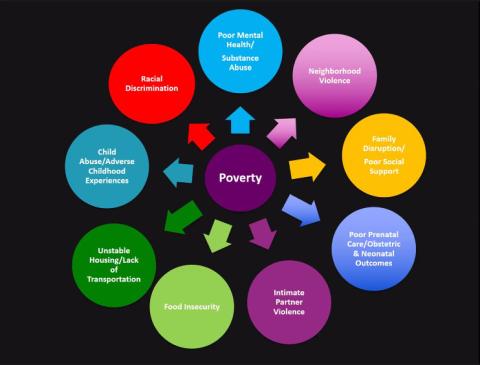Rogers Studies Factors that Optimize Infant Brain Development

Social and economic disadvantages can affect the developing brain, impeding opportunities for children to thrive. Research shows these adverse exposures also can have an impact in infancy and even earlier.
Dr. Cynthia Rogers uses magnetic resonance imaging (MRI) to study how social determinants of health affect early brain development. Socioeconomic imbalances, she said, “set off exposure, both prenatally and postnatally, of the developing brain to a lot of factors that we think lead to impaired development and then ultimately to poor outcomes for the child.”
These social determinants—economic stability, education, access to quality health care, food security, neighborhood environment—are all interconnected and account for as much as 75 percent of population health outcomes, Rogers noted. Disparities, amplified by racial biases, often are rooted in poverty.
Children who grow up impoverished are more likely to have developmental challenges. “Now we’re increasingly showing [via] science that this is potentially [due to] changes we are seeing in the brain,” said Rogers, a child psychiatrist and professor of psychiatry and pediatrics at Washington University. She discussed her research at a NIMH Director’s Innovation lecture earlier this year.

A baby’s brain develops rapidly in utero, growing in size and complexity particularly in the third trimester, and in the first couple years of life.
“The immature brain, because of this rapid brain growth, is more vulnerable to the environment and to the social determinants that these children can be exposed to both in utero and ex utero,” Rogers said.
Studies have linked the volume of cortical brain matter (related to attention and memory) and the hippocampus (involved in learning and memory) to socioeconomic status. Both prenatally and postnatally, psychosocial stress related to poverty, not to mention such related factors as poor nutrition and environmental toxins, can have adverse effects on the developing brain.
Rogers focused her presentation on two NIMH-funded studies conducted by her lab. One of them, the preterm birth study, examines changes in brain structure and function in premature babies, who are at greater risk for developmental issues and psychiatric disorders, particularly anxiety, attention deficit-hyperactivity disorder and autism spectrum disorder.

The babies in the study are fed and swaddled, then take a nap as they enter the MRI scanner. Researchers look at colors and signals of brain networks related to cognition and psychiatric symptoms. When they scanned babies born at 27 weeks gestation, then conducted developmental follow-up at ages 2 and 5, they found activity in multiple brain regions in the neonatal scans that predicted symptoms related to social skill and attention deficits at ages 2 and 5.
This finding is important for disparities research. In the U.S., Black women have the highest rates of preterm birth. Rogers’s lab is finding growing evidence that prematurity has profound effects on the newborn brain and that preterm birth correlates with poverty.
“If you think about social determinants, a lot of it has to do with where you live, where your school is and access to resources,” said Rogers.
Using the area deprivation index developed by the University of Wisconsin, Rogers’s lab found strong links between neighborhood poverty and striatal connectivity to the prefrontal cortex. In other words, neighborhood poverty during the prenatal and perinatal period is related to brain connectivity at birth.
A larger study, e-LABE (Early Life Adversity and Biological Embedding), sheds additional light on how socioeconomic disadvantage affects the neonatal brain. In a sample of 400 babies scanned at birth, those from more socioeconomically disadvantaged homes had less cortical gray matter and white matter volumes. Researchers also observed effects across different brain regions among infants whose mothers experienced psychosocial stress while pregnant.
Kids, however, can be resilient. But can they overcome poverty-related brain changes?
“I think a lot of folks are concerned about stigmatizing children by saying if you’re in poverty, your brain changes,” Rogers said. The good news is some studies are showing “there are ways in which your brain is developing optimally for the environment that you’re in and there might be ways your brain develops that can still make you successful.”

One way to mitigate disparities and improve cognitive and behavioral outcomes is through anti-poverty programs and other assistance to improve economic stability. Another is to improve health care equality, including better routine and preventive care for mothers and babies.
Rogers continues doing her part to help. She founded and co-directs the Perinatal Behavioral Health Service (PBHS) in St. Louis, where social workers, therapists and psychiatric clinicians provide mental health and substance use care in pregnancy and postpartum, as well as education, screening, care coordination and mental health treatments.
PBHS operates inpatient and outpatient care throughout the Washington University Medical Center. More than half of the patients have an income of less than $20,000 and most are on Medicaid. About half are Black perinatal patients, the demographic least likely to have access to mental health care, noted Rogers.
“We really are passionate about the fact that this should be done in an equitable way,” she said, “and increasing access to care for those who typically don’t receive it.”
Recently, the service also began addressing basic needs. PBHS added a food pantry, offers referrals to a range of community resources and is piloting a housing assistance program.
“If we’re interested in improving health, either through research or through clinical care, how can we do that if we’re not addressing [the social determinants] responsible for three-quarters of the outcome?” asked Rogers. “It’s really important that we embrace this as health systems, as practitioners.”
For more information about the monthly NIMH Director’s Innovation Speaker Series, see: https://go.usa.gov/xuza7.
